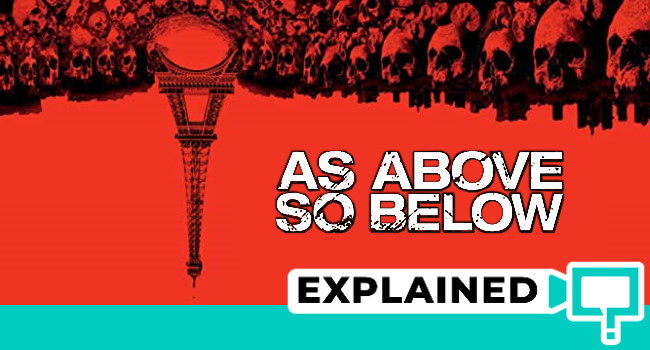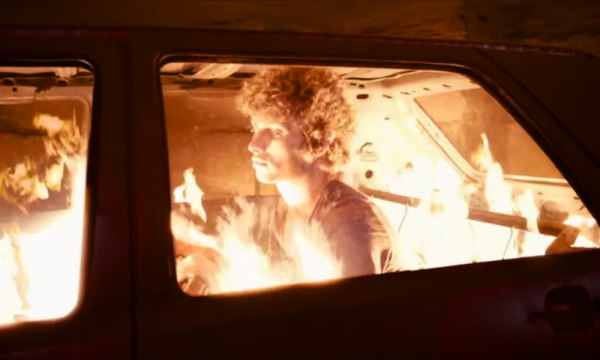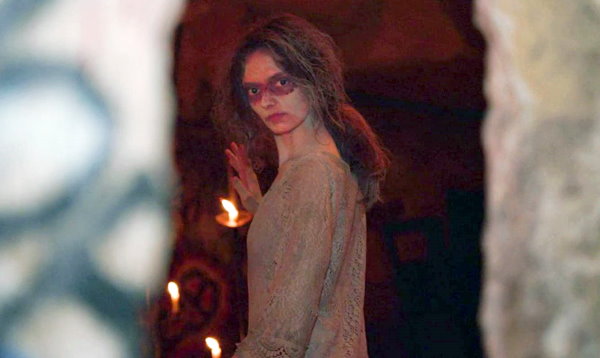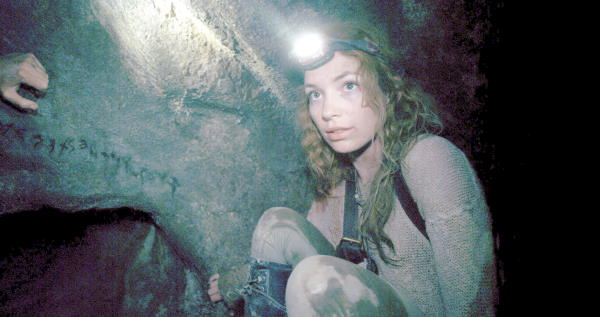The theme, ideas, and setting of As Above, So Below had immense potential. After all, what can go wrong when you put together Dante’s Inferno, the Paris Catacombs, and a story of adventure and redemption? Quite a bit, as it turns out. The key to any good story is its narrative techniques, its characters, and most importantly, its execution. Here’s how and why this movie fell short of greatness, even though it had all the necessary tools to make it. Here’s the plot and ending of As Above So Below explained; spoilers ahead.
Hollywordle – Check out my new Hollywood Wordle game! Where To Watch? To find where to stream any movie or series based on your country, use This Is Barry’s Where To Watch. Oh, and if this article doesn’t answer all of your questions, drop me a comment or an FB chat message, and I’ll get you the answer. You can find other film explanations using the search option on top of the site.
Contents
Here are links to the key aspects of the movie:
- – What is it about?
- – Plot Explained: Washing Away the Sins
- – Everyone doesn’t get an equal chance!
- – Misrepresentation of sins
- – The Philosopher’s Stone
- – Who is on the chair?
- – Frequently Asked Questions Answered
- – Issues with the main character, Scarlett
As Above So Below: What is it about?
A young scholar, tormented by her father’s death, a famed archaeologist, is seeking the key to finding Nicholas Flamel’s Philosopher’s Stone. She soon discovers the answer lies in the catacombs under Paris and gathers her friends, and some locals, to help her in her quest. Soon, unnatural things start happening, and the group finds themselves in literal hell on Earth.
While the movie is not based on a true story, the setting is real. The Catacombs below Paris are a place that sprawls for miles and miles. Moreover, it’s estimated that over 6 million people are buried there.
Naturally, this is a found footage horror, which is why it’s inevitable that they get lost and off the grid. Had they had an HQ with fast fiber optic internet somewhere in the catacombs, this would have worked out differently. Alas, the movie had a trope to play into.
As Above, So Below: Plot Explained: Washing Away the Sins
The references to Dante’s Inferno are more than evident throughout the movie. The problem is that the sins are incredibly unconvincing from moral, spiritual, and religious standpoints, as well. In the end, it seems like this fictional hell is a place designed to trick people or help them overcome trauma, which is not the way it’s supposed to work.
What was George’s Sin?
For instance, George’s brother drowned (when George was still a child), and George feels guilty for not getting there in time. Plenty of people feel guilty over things that are just not their fault, and this is not what hell is supposed to punish for. A guilty conscience is not supposed to be a ticket straight to hell. This means that George’s sin is… not running fast enough or getting lost? Just wow.
What is Scarlett’s sin?
A similar thing goes for Scarlett, who feels guilty about not answering the phone the night her father died. Is neglecting your parents ‘bad’ from a moral standpoint? It is. However, is “Thou shall not put thine father’s calls on silent” a mortal sin? It’s not supposed to be. Again, it’s completely understandable why she’s feeling guilty and that she won’t be able to move on until she forgives herself. It also gives the character a lot in terms of motivation to make this relentless drive. But one thing it’s not is a mortal sin punishable by hell.
As Above, So Below: What was Benji’s sin?
Some point out some “lustful gazes” that he directs at several points in the movie, but it’s nothing conclusive. If Benji does have sin, they failed to portray it. If they did portray it, they didn’t do it well enough.
Though we see Benji attacked by a Mother with a baby, this was Zed’s sin as he mentions that he refused to acknowledge a kid he knew was his. When it comes to Benji’s sin, it’s left vague.
As Above, So Below: Why did Siouxsie die? What was Siouxsie’s sin?
Siouxsie’s sin is yet another unclear aspect of the film. Before she or the viewers realize she has a sin that she needs to repent, Siouxsie is killed.
As Above, So Below: What was Papillion’s sin? Why did Papillion die?
That burning person was supposed to be his friend whom he left behind to die while saving his own life. The method of his death was far more significant, seeing how his feet sticking from the ground closely mimicked an actual scene from Dante’s Inferno.
Everyone doesn’t get an equal chance!
One of the main ideas is that each of our protagonists has a sin they must repent for. However, some characters, like Siouxie (Pap’s girlfriend) and Benji (the original cameraman), are killed before they’ve even gotten a chance to repent. They’re killed before anyone in the movie (or the audience) even figures out that this is the modus operandi of the catacombs. Pap and Zed are the only people with actual sins, yet, they get criminally little screen time compared to the rest.
Misrepresentation Of Sins
One of the biggest problems with the movie lies in the fact that it has a severe problem understanding or defining sins that it’s punishing its characters for. Take, for instance, greed. Pap and Siouxie encounter a vast pile of gold in one scene and almost die trying to claim it.
Seeing gold and wanting to take it is not a sin. Wanting to take more than you need, always being hungry for more, and taking from others is what all the spiritualists and philosophers preach against. For instance, had Benji (for example) had his leg trapped, and instead of helping him, Pap and Siouxie went for the gold instead, this scene would have been perfect. This is precisely what we meant by – a missed opportunity.
It’s not that a popular cultural representation of a mythical place can’t work. In The Lighthouse, a pseudo-purgatory was done exceptionally well. It’s just that this movie fell a bit short.
As Above, So Below: What was the stone? The Philosopher’s Stone
Another theme of the movie, the Philosopher’s Stone, is the original MacGuffin. It’s something that everyone seeks because it’s seek-worthy and has all sorts of magical properties, depending on the story. Initially, it was mentioned to turn any substance into gold, prolong life indefinitely, cure all diseases, etc., but the latter half of the movie doesn’t give it enough focus.
Now, don’t get us wrong, there are so many examples of where MacGuffin works incredibly well as a narrative vessel. A perfect example of this is the briefcase from Tarantino’s Pulp Fiction.
As Above, So Below: Who is the man on the chair?
The monsters of As Above, So Below are gargoyles, designed as the guardians of the place, and at one point, we see a man sitting on a wooden chair, which might just be this movie’s depiction of Satan. After all, this is how he was portrayed in Dante’s Inferno.
Frequently Asked Questions Answered
What does As Above, So Below Mean?
The phrase in the movie suggests that what they believe in the lower layers of the catacombs will become their reality.
Most likely, it’s another form of – Thy will be done on earth as it is in heaven. In other words, it’s a part of Our Father, which is meant to indicate the deeply religious themes that were to be covered in the movie. Here’s the dialogue:
What is within me is outside of me. As it is on Earth, so it is in heaven. As I am, so are my cells, so are my atoms, so is God. Basically, as I believe the world to be, so it is.
As Above, So Below: What happened to La Taupe?
La Taupe is supposed to be their dark, twisted version of Virgil. Dante had his guide through hell, and they have theirs.
As Above, So Below: Why didn’t the stone work?
The stone didn’t work because of the abstract concept of the movie that true power lies within our souls rather than a physical divine article. Only after forgiving herself and changing her ways was she allowed to perform miracles.
As Above, So Below: Then How did Siouxie heal?
The stone itself appears to have some magical properties. However, it may be just a trick to get the crew on the wrong trail.
After all, a higher power could have known that Siouxie’s healing would not have impacted the expedition’s outcome, as her death was around the corner either way. On the other hand, it’s just as possible that this is a massive plot hole.
As Above, So Below: Did they get out?
Yes, looks like they got out. Chances are that the hole they exited the catacombs through is not a real passage but a portal to the spiritual world.
At one point in the movie, they head down but return to where they left off but inverted. So it looks like they were headed to the surface again from that point on.
As Above, So Below: Who were the cultists and who was the girl?
Chances are that the girl is more of an omen (a lost spirit wandering between our plane of existence and the next). On the other hand, cultists are possibly just representations of some of the strangest things in obscure parts of actual catacombs. The truth is that the movie leaves too many plotholes for every single scene to have meaning.
Issues with the main character, Scarlett
Arguably the most underwhelming aspect of the movie is its main character. Scarlett Marlowe is the ultimate Mary Sue, a character with new skills attributed to her every time she needs it, daring, courageous, and driven. In theory, this doesn’t have to be so bad. After all, she was clearly envisioned as a less violent Lara Croft, a universally loved strong female character. The problem, however, lies in the execution.
First of all, her intelligence often seems like omniscience rather than deduction. For instance, when she encounters the number of the devil, 741, she immediately recognizes that this means that hell is 741 feet below the earth. Why feet? Why not meters, miles, kilometers, leagues, paces, yards… you get the drift.
Second, her competence is often stressed out not through her merit but by making everyone around her seem more incompetent. Not to forget luck, which plays strongly into her characterization in the movie. Taking a headstone off a church wall and charring it with a lighter is an action that has a word – vandalism. However, it just so happens that her guess is correct every single time, so she’s let off the hook, seeing how she was right, to begin with.
Lastly, she’s obnoxious and selfish, at least at the start of the movie. While this is not a writing flaw, it does make it hard to get behind her objective. At the very beginning, she goads her friend George (a person with claustrophobia) to go with her to the catacombs (since she might need him later). This is what the definition of a bad friend is. It’s also implied that she left him in a Turkish prison and bailed some years prior. Sure, she later risks her life to save him, but honestly, this is the only redeeming moment for her throughout the movie.
As Above, So Below: Is Scarlett the stone?
It appears so, as indicated by her reflection and the fact that she could heal George. It’s unclear if she was the stone all the while or if she became it in the catacombs. Honestly, the film ends so abruptly that it’s hard to deduce anything.
In Conclusion
In the end, the movie is not horrible. It’s just underwhelming. The sad part is that it did a few things right, like Scarlett’s redemption ark and the atmosphere. Still, when comparing the good and the bad, the outcome is not very good as it leaves too many open questions.
What were your thoughts on As Above, So Below? Do leave a comment with your thoughts.

Stacey is a talented freelance writer passionate about all things pop culture. She has a keen eye for detail and a natural talent for storytelling. She’s a super-fan of Game of Thrones, Cats, and Indie Rock Music and can often be found engrossed in complex films and books. Connect with her on her social media handles to learn more about her work and interests.




